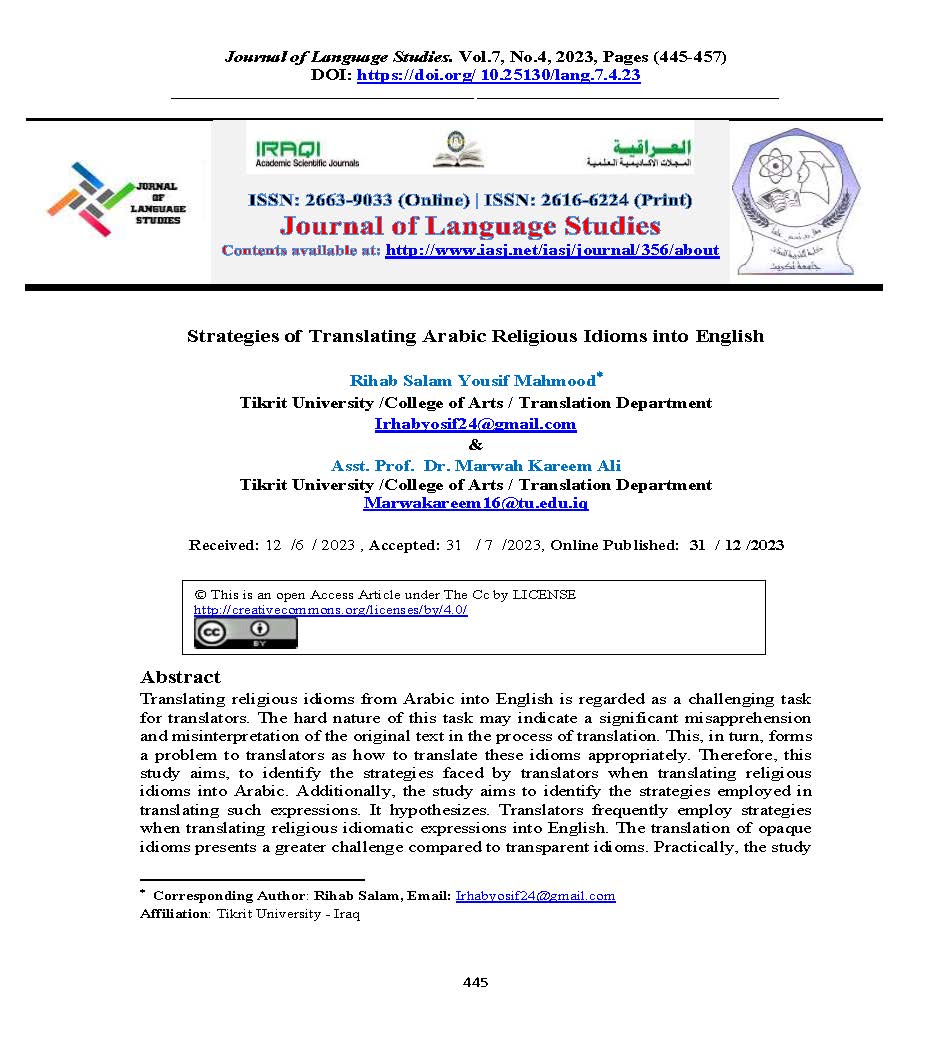Strategies of Translating Arabic Religious Idioms into English
DOI:
https://doi.org/10.25130/lang.7.4.23Keywords:
Translation, Strategies, IdiomsAbstract
Translating religious idioms from Arabic into English is regarded as a challenging task for translators. The hard nature of this task may indicate a significant misapprehension and misinterpretation of the original text in the process of translation. This, in turn, forms a problem to translators as how to translate these idioms appropriately. Therefore, this study aims, to identify the strategies faced by translators when translating religious idioms into Arabic. Additionally, the study aims to identify the strategies employed in translating such expressions. It hypothesizes. Translators frequently employ strategies when translating religious idiomatic expressions into English. The translation of opaque idioms presents a greater challenge compared to transparent idioms. Practically, the study sample includes a total of (4) religious idioms, selected from Arabic theses conducted of department of Islamic sciences and Arabic language at University of Tikrit. These (4) idioms were translated by (4) MA student in the department of translation, College of Arts, University of Tikrit. This study employs two models for date analysis, one is proposed by Moon (1998), which encompasses four distinct categories of idiomatic expressions, namely transparent, semi-transparent, opaque, and semi-opaque. Nida's (1961) proposed translation strategies differentiate between two approaches, namely the formal and dynamic equivalence methods. The study reveals that M.A. students encounter numerous obstacles when translating religious idioms, primarily due to lack of understanding regarding the cultural disparities between the English and Arabic language.
References
Al- Khatib, A. n.d. Curricula for Translating Religious and Sharia Term Holy Qur’an: “Allah, Prayer, Fasting, Zakat, Hajj and the Name of Surah” with an Introduction to Translation of the Holy Qur’an into English.
Al-Hannash, M. (1991). “Molahazat Howl Alta’ber Almashkuka fi Al Logan Al-Arabiya”. Journal majalat al tawasil, 3: 29-40.
Allam, R. Translating Idiomatic Expressions from Arabic into English in Assam Youssef’s A Quarter Gram: Challenges and Strategies. Bulletin of the Faculty of Arts Volume 79 Issue 4 April 2019
Allan Bell, The language of news media. Oxford: Blackwell, 1991. pp. xv + 277.
Baker, M. (1992). In Other Words- A Course Book on Translation. London: Routledge.
Baker, M. (1992). In other words- course Book on translation. London: Routledge
Baker, M. (2018). In Other Words: A Coursebook on Translation, 3rd edition. Oxon: Routledge.
Ball, W. (1968). A Practical Guide to Colloquial Idiom. London: Longman Group Ltd.
Carcieri, C. and Tabossi, p., (1993). “Idioms: Processing Structure, and Interpretation”, Psychology Press: Lowrance Erlbaum Association, Inc., p.12.
Dweik, B. S. & Thalji, M. B. (2016). Strategies for translation proverbs from English into Arabic. Academic Research International 7(2), 120-127. Retrieved from: www.savap.org.pk 120 www.journals.savap.org.pk
Fernando, C. (1996). Idioms and Idiomaticity. Oxford: Oxford University Press.
Ghazala, H. (2003). Idiomaticity between evasion and invasion in translation: Stylistic,
Halima, A. (2020). English- Arabic- English Translation: A Novel Methodological Framework for The Standardization of Translation Parameters. Journal of English Language and Literature Studies.10(3) RetrivedApril25,2022,from http://ccsenet.org/journal/index.php/ells/article/view/0/43105.
Heacock, P. (2006). Cambridge Dictionary of American Idioms. Cambridge: Cambridge University Press.
Hussein, R. F, Khanji, R. and Makhzoomy, K.F. (2000). The acquisition of idioms: Transfer or what? J. King Saud University, Lang. & Transl. (12), 23-34.
J. C. Catford. (1965). Linguistic theory of Translation, Oxford university press.
Juma’a, O. (2014). Translating Idiomatic Expressions from English into Arabic (MA Thesis, Middle East University, Amman, Jordan). Retrieved from: https://meu.edu.jo/library Theses/5870cd9386929-1.pdf.
Langlotz. (2006). Idiomatic Creativity: A Cognitive Linguistic Model of Idiom-Representations and Idiom-Variation in English. Amsterdam - Philadelphia: John Benjamins.
McDowell, I. and Maclean, L. (1998). Blending qualitative and quantitative study Methods in Health Service Research, Health Informatics Journal No.4, pp.15-22.
McGuire, S. B. (1980). Translation studies. London and New York: Methuen.
McPartland, M. (1998). The use of narrative in geography teaching. The Curriculum Journal, 9(3), 341-356.
Moon, R. (1998). Fixed Expressions and Idioms in English: A Corpus-Based Approach. Oxford: Clarendon Press.
Newmark, p. (1981). Approaches to Translation. Oxford University Press.
Newmark, P. (1988). A Textbook on Translation. New York: Prentice Hall.
Nida, E. & Charles R. Taber (1969). The Theory and Practices of Translation. LEIDEN: Brill; and New York: United Bible Societies.
Nida, E. (1964). Toward a Science of translating. Johan Benjamins publishing Company.
Nida, E.& Taber, C. (1969). The Theory and Practice of Translation. LEIDEN: E. J. Brill.
Numberg, G., Sag, I.& Wesaw, T (1994). Idioms. In: S. Everson, eds. Language. Cambridge: Cambridge University Press, pp.491-538.
O’Dell, F. & McCarthy, M. (2010). English Idiom in Use, Cambridge: Cambridge University Press.
Oualif, M. (2017). Translating idiomatic expressions from English into Arabic: Difficulties and strategies. World English Journal for Translation & Literary Studies, 1(3), 22-31. DOI: http://dx.doi.org/10.24093/awejtls/vol1no3.2
Palmer. (1976). Semantics. Cambridge University Press.
Vinay, J. P.& Darbelnet, (1995). Comparative Stylistics of French & English: A Methodology for Translation, Benjamins Pub.

Downloads
Published
Versions
- 2023-12-31 (2)
- 2023-12-31 (1)
